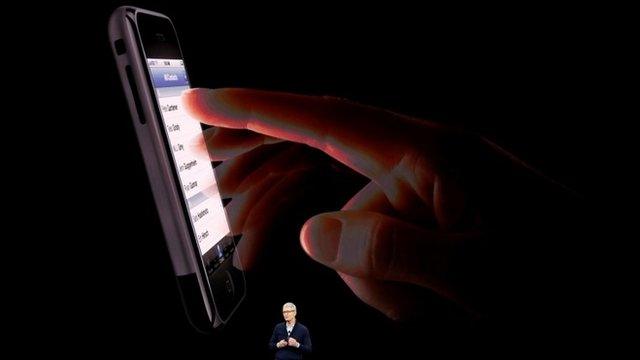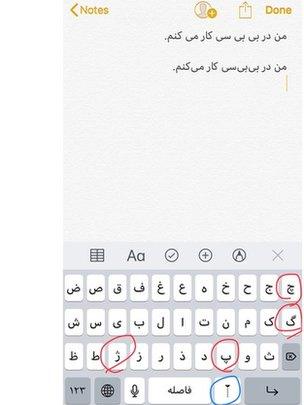The long wait for a Persian iPhone keyboard
- Published

Apple introduced new iOS on Tuesday
Android devices as well as Apple computers have Persian keyboards, but until this week the option wasn't available on Apple phones or iPads.
For years Persian speakers used the Arabic keyboard on the iPhone, which was not really ideal for writing quickly or accurately in Persian.
There were lots of petitions to Apple, pressing them to add a Persian keyboard to mobile phones. That finally paid off with the latest release.
Arabic and Persian keyboards are very similar. But there are two major issues - the four extra letters in Persian - and the "half space" feature needed for a well-edited Persian message.
In order to type the extra four letters in our alphabet we had to press and hold another letter and wait for a window to pop up so we could drag our finger on it and see it on screen.
Yet that was still doable. The "half space" was the more serious issue.
In Persian, the letters in a single word are joined-up. Some words we make by combining two words together. These compound words should be near but not attached to each other.
On Apple and Microsoft computers, as well as in Android devices we have long been able to use a "half space" to separate words but keep them close enough. A hyphen does almost a similar task in English. But the half space is used far more in Persian.

First line is typing without half space and the second line has the half space. Extra Persian letters are circled in Red. Half space button has a blue circle around it.
For example: "I work for the BBC."
If I want to write this sentence in Farsi, I use the "half space" three times to keep the BBC letters close to each other and to join two parts of the verb.
For several years, many Iranians and Afghans signed petitions, hoping to add the keyboard. One of my friends personally wrote to Steve Jobs twice, but never heard back.
Even though Apple could have given us this option sooner, I took the joy of having a proper keyboard to Twitter and wrote about it there.
Some Android enthusiasts replied to me, saying their devices had it for "ages".
Others wondered why Apple would add the keyboard as they abandoned Iranian apps.
Recently Apple has removed some apps developed in Iran from their stores. Snapp, a popular ride-hailing app like Uber, was one of those affected. Apple said it was deleting them due to US sanctions, but some Persian cooking apps or video streaming apps developed outside Iran were also deleted. Google did not take the same measures.
Even though many see Apple's recent moves as a double standard, I still think having a Persian keyboard is good for our language.
Persian written in the Persian alphabet is common in only two countries: Iran and Afghanistan.
During the time of the Soviet Union, Iranian elites often sent their sons to Europe and the USSR to study.

Amazed by the Western world, some suggested we should change our alphabet to Latin, much like Turkey did. Others argued we would cut our ties with our literary heritage, and those arguments won out. We ended up keeping our alphabet.
Then came the era of computers and smartphones. Early technology did not support the Persian alphabet. So my generation, who grew up in the 80s and 90s, started writing Persian with a Latin alphabet on computers and early phones, calling it Farglish.
Because of the sanctions, Apple and other major tech companies do not have any legal presence in Iran and as some of these smartphones are considered expensive, they don't have a big market in Iran and Afghanistan.
One may wonder why it was important for us to have a Persian keyboard on devices that not many Iranians own.
The answer is that we do care about our cultural heritage and appreciate any attempt to have a better connection with our great poets and writers - masters like Sa'di, Rumi, Hafiz, Ferdowsi, Khayyam and others.
A text for me is like a wall. Every word is like a brick. If I want to build a sturdy and beautiful wall I cannot use broken bricks. I don't want any extra space between the pieces of a brick.
As a journalist or even as a user on Twitter, I would like to make a good impression on my audience.